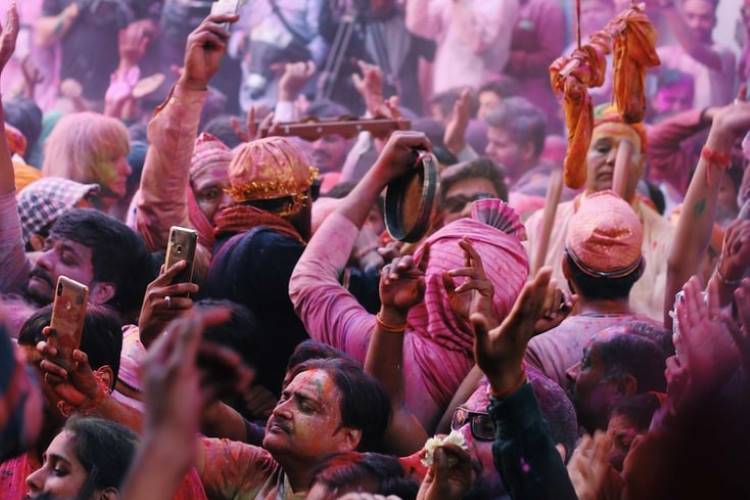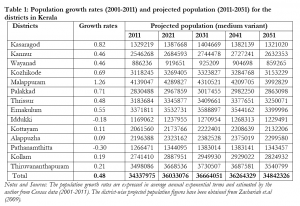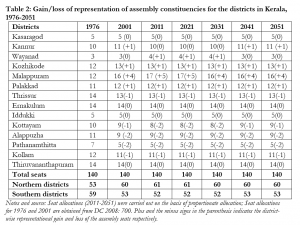
Population growth and delimitation efforts: Indian democracy has been facing a typical representational crisis in some of its prominent electoral bodies such as the Lok Sabha and the state legislative assemblies. One of the principles enshrined in the country’s constitution is ‘one-man (person), one-vote, one-value’. The 42nd Amendment Act (1976) of the Constitution, however, prohibited further reallocation and redrawing of the boundaries of the constituencies of the Lok Sabha and state assemblies until the population figures for the first census after 2000 were released. Subsequently, this constitutional embargo was extended to post 2026 through the 84th Constitutional Amendment Act, 2001. This means reallocation of representation to the above electoral bodies will take place only after the census of 2031. Such a constitutional ban has multifaceted consequences, an often-debated aspect being the violation of the abovementioned voting values. This issue is crucial, especially in the context of India’s booming population as well as of the demographic diversity prevailing in the country.
There is ample evidence in the literature that deals with demographic divide which exists between the northern and southern states (Bose 2000, Dyson 2004). The southern states are demographically much more advanced (about two to three decades ahead) compared with the northern states. As a result, the major southern states (Kerala, Karnataka, Tamil Nadu, Andhra Pradesh and Telangana) have reached below replacement fertility levels. On the other hand, in northern states (Uttar Pradesh, Bihar, Rajasthan, Madhya Pradesh, Uttarakhand, Chhattisgarh and Jharkhand), the demographic transition process has been slow. Without enhancing the strength of the House, the reallocation of seats on the basis of the population proportionality paragon would result in a loss of representation. This is the context in which the constitutional freeze on political representation has been imposed, i.e., to not punish those states that have successfully implemented family planning initiatives.
READ I Climate change: IPCC report warns of closing window of opportunity
Constitutional freeze on delimitation
In the context of the constitutional freeze on the Lok Sabha and state assemblies, there has been a broad consensus among scholars that the strength of state houses should be enhanced. They argue that although the freezing of LS representation has been logical (southern states should not lose their representation for containing population growth), it is illogical to freeze the number of assembly seats. These experts are for the enhancement of representation in states in line with the current demographic trends (Verma 2002, Chakraborty and Sen 2009). They say that most of the states have reached below replacement fertility levels and enhancing the strength of assemblies would allow the House to have better representation of the people in accordance with their current demographic weighs. Furthermore, such a realignment would not disturb the representational balance of states. This paper examines the above hypothesis to show the extent to which the realignment of assembly seats will impact the representation pattern of districts in Kerala.
Table 1 provides district-wise estimates of population growth rates and projected population figures for the period 2011-2051. It is clear from the table that there are significant inter-district variations in population growth even within Kerala, the most demographically advanced state in the country. The northern districts (Palakkad to Kasaragod) have higher average population growth rates than the southern districts (Idukki to Thiruvananthapuram). All the southern districts are well below the average rate of population growth. During the last intercensal period, Idukki (-0.18%) and Pathanamthitta (-0.30%) reported negative population growth rates. In contrast, Malappuram district had a population growth rate that was two and half times higher (1.26%) than the average population growth rate of the state (0.48%).
This shows that population growth rates could vary significantly across districts even in low fertility scenarios. However, it should be noted that variations in population growth rates are neither as pronounced nor identical to India’s north-south demographic divide of the states identified by the scholars. The real apprehension is, therefore, like the representational loss of states in the Lok Sabha for controlling their population growth; districts with similar demographic trends will experience identical representational loss in state assemblies. This happens only when the principle of population proportionality has been applied in order to redistribute the representation.
READ I Labour market: Concerns over informalisation of workforce
The application of the principle of population proportionality should be addressed in the broader context of the existing constitutional provisions underpinning the blanket ban on the allocation of assembly seats. From a democratic point of view, the principle of population proportionality in the distribution of seats can be justified, but cannot be strictly adhered to when inter-district variations in population growth rates are visible. We shall discuss this issue a little more closely by looking at the proportional allocation of assembly seats for the districts in Kerala with relatively minimal variations in their population growth rates.

It is interesting to assess the future representational position of two sets of districts (high fertility versus low fertility) in the Kerala assembly (Table 2). In order to allocate district-wise assembly seats, the average population per constituency at the state level was estimated by dividing the total population of the state with the current size of the state assembly (140 seats). The entitled seat shares of the districts were obtained by dividing the population of the districts with the average state population per constituency after the fractions were rounded off. The Delimitation Commission has provided seat allocations in the past (1976 and 2001) and a new representational assessment was carried out for the subsequent periods (2011-2051).
The exercise of the Fourth Delimitation Commission (2001) held after a gap of three decades was intended to realign the assembly seats in proportion to the current demographics. The northern districts had gained an additional seven seats (53 to 60) and the corresponding loss to the southern districts was six seats (59 to 53).The districts that gained additional representation include Malappuram (four seats) followed by Kannur, Kozhikode and Palakkad (one seat each). On the flip side, Alappuzha and Pathanamthitta lost a couple of seats each whereas Kottayam and Kollam districts lost one seat each. The result establishes a casual linkage of how population growth rates of the districts influence their representational pattern. The outcome of the delimitation exercise and the proportionate allocation of representation does not show justice to the districts that have controlled the population growth rates. Rather, such districts are being penalised in the form of reduction in their assembly seats for their relentless efforts in curbing population growth. In other words, for no reason, the centre of power in representations is being shifted from less-populated districts to heavily populated districts in the state.
Like the southern states that will lose representation in the Lok Sabha, districts that controlled population within states are getting double blows by losing their existing representations in the Lok Sabha as well as in assemblies. These results are universally applicable to all districts in the country with regard to the allocation of seats in state assemblies after the delimitation exercise. It raises the important question of whether it is justifiable to penalise the districts (by reducing both Lok Sabha and assembly seats) that controlled population growth? Could we maintain equality in the voting values of districts even when some of the districts experience relatively higher population growth rates than others?
The answer to both questions is certainly a firm no. Furthermore, similar to the trends in the Lok Sabha, procrastination of delimitation of the assembly constituencies would have created inequalities in representation and discrepancies in the vote values of the population that elects the MLAs. However, the Fourth Delimitation Commission has brought population equalities at the constituency level by bringing better population-assembly ratios and a parity in vote values across the assembly constituencies within the states. Such benefits would last only till population growth rates across the districts tilt the equilibrium of population-assembly parties in representation. Nonetheless, due to varying population growth rates in districts within a state, such changes at the constituency levels are inescapable.

Table 2 highlights the impact of population growth on the distribution of assembly seats till the end of the projected period. For instance, the population growth rate of the state would have an impact on the district level realignment of the assembly constituencies only till 2031. Thanks to the current constitutional embargo, the redistribution of assembly seats is only likely to take place through a census held at that time. The northern states would have added one more seat to their kitty (60 to 61) at the cost of the southern states (53 to 52 seats) if there had been a delimitation in the previous census (2011) and in the forthcoming census (2021). With the exception of the districts of Wayanad, Kannur and Kottayam, the individual seat positions of the districts in the state assembly would maintain the status quo of 2001 delimitation.
This is because all districts in the state would be moving towards population stabilisation, accompanied by negative population growth rates, as projected population figures suggest (Table 1). It demonstrates the role of population stabilisation principle in the constitutional freeze regime that had frozen the realignment of political representation. The National Population Policy 2000 (NPP) assumed that the nation would reach the stage of population stabilisation by 2026, and thus the year has been fixed for lifting the constitutional freeze. However, the country’s failure to achieve some of its medium-term objectives will result in substantial delays in achieving the broader objectives outlined in the NPP. Thus, within the stipulated time frame of 2026, the nation will not accomplish the most celebrated population stabilisation objective.
Not the right time for redrawing seats
Without a commensurate increase in the strength of the Lok Sabha, enhancing the strength of the assemblies will adversely affect the voting value of the electoral college that elects the President. As of now, there has been some parity in the state level voting values of the MPs and MLAs who elect the president in the context of freezing the representations. Increasing the strength of assemblies will automatically result in the spiralling of the voting values of MLAs compared with that of the MPs, which in turn will disrupt the vote values of the electoral college. In addition, another constitutional amendment becomes mandatory for enhancing the strength of state assemblies.
The analysis clearly underlines the fact that even when the state enjoys the lowest fertility levels, districts within the state may have different fertility, mortality and migration trajectories, leading to variations in their population growth rates. In a low fertility scenario, keeping in mind the representational loss of districts, the situation could be envisioned in some of the heavily populated northern states with an extreme demographic divide and significant rural-urban differences. As of now, there are no reliable estimates of population projections for the districts in northern states to carry out identical constituency-level representational assessments.
These results largely negate the arguments put forward by scholars in favour of augmenting the strength of the assemblies without visualising the reality at the grassroot level. In a way, both the components of constitutional freeze on representation are inseparable and cannot be kept in watertight compartments. Rather, within the constitutional framework, the legitimate freeze imposed on their representation should be mutually reinforced not only to maintain the federal balance of the country, but also to maintain the parity in the vote values of the electoral college that elects the President.
Therefore, it is not advisable to increase the strength of state assemblies. In addition, this calculation validates the hypothesis that population stabilisation of a region is mandatory to have a fair and long-lasting impact on the distribution of seats in a given geographical area. The recommendations of the NPP to extend the constitutional freeze precisely figured out the consequences of enhancing the strength of the Houses before the nation fulfils the criterion of population stabilisation. Thus, by freezing both the representations in the Lok Sabha and state assemblies, the constitutional amendments were also in the right direction. Population stabilisation at the national level, however, cannot be a panacea for the representational crisis as not all states would pass this test.
References:
Bose, Ashish (2000): North-South Divide in India’s Demographic Scene, Economic and Political Weekly, May 13-19, 35 (20): 1698-1700.
Chakraborty Biswanath and Sen Debashis (2009): Delimitation Commission: Working and Impact, Progressive Publishers, Kolkata.
Delimitation Commission of India (2008): Changing Face of Electoral India: Delimitation 2008, Volume I, New Delhi.
Dyson Tim (2004): India’s Population-The Future in T. Dyson, Robert Cassen, and LeelaVisaria (ed), Twenty First Century India: Population, Economy, Human Development, and the Environment, Oxford University Press, New Delhi.
Verma A K (2002): Issues and Problems in India’s Delimitation Exercise, Indian Journal of Political Science, 63(4), Meerut.
Zachariah KC, S Irudaya Rajan and Sabu Aliyar (2009): Kerala: Population Projections at State, District and Taluk levels, UNDP/Planning Commission Project on Strengthening State Plans for Human Development, HDRC Unit, Kerala State Planning Board, Thiruvanathapuram.
